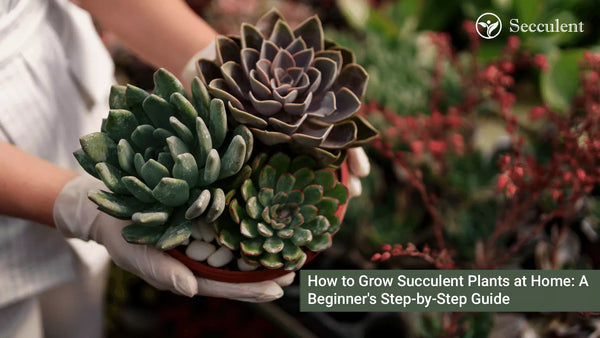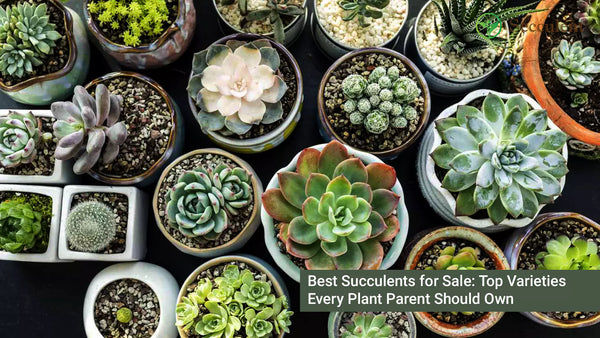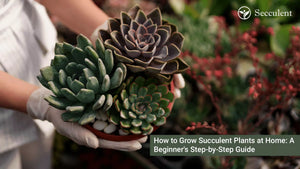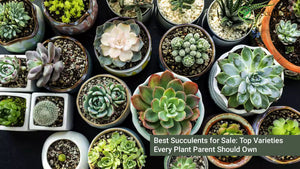Seasonal Succulent Care: Summer Survival Guide

Succulents are popular for their stunning aesthetics and hardy nature, but even these resilient plants can face challenges during the scorching summer months. Excessive heat, frequent sun exposure, and improper watering can threaten their survival.
If you're a succulent owner trying to keep your green beauties thriving during summer, you're in luck! This seasonal care guide will walk you through everything you need to know—from protecting them from overheating to perfecting your summer watering schedule.
What You’ll Learn in This Guide:
- How high temperatures affect succulents
- Proper watering techniques tailored to summer survival
- Tips for adjusting light conditions to prevent sunburn
- The best soil and potting methods for hot weather
- Common summer problems and quick solutions
Let's ensure your succulents make it through summer healthier and more vibrant than ever.
How Succulents Handle Heat
Succulents originate from arid climates and are built to store water in their leaves, stems, and roots. However, contrary to popular belief, that doesn’t mean they’re invincible under intense summer conditions.
During summer, succulents enter a survival mode called “summer dormancy.” This natural phase helps them conserve energy as they endure extreme heat. While dormant, succulents demand less water and are more vulnerable to stress from overwatering and direct sunlight. Understanding this dormancy is essential for proper care.
Signs Your Succulents Are Struggling with Heat:
- Sunburn: White or brown patches on leaves after too much sun
- Shriveling Leaves: A symptom of dehydration, often caused by insufficient watering
- Wilting or Drooping: Indicates stress, which may result from overwatering, poor soil drainage, or intense heat
With this in mind, let's explore how to protect your succulents this summer.
Step 1: Perfect Your Summer Watering Schedule
One of the biggest mistakes succulent owners make in summer is overwatering. It might seem counterintuitive, but succulents thrive on "less is more" when it comes to moisture, even in hot weather.
Tips for Watering Succulents in Summer:
- Test the Soil: Only water when the top inch of soil feels bone dry.
- Focus on the Roots: Direct water to the soil, avoiding the leaves, as wet leaves can rot under intense sun.
- Timing is Key: Water succulents in the morning or late evening to minimize evaporation and supply hydration when they’re least stressed by heat.
Remember, yellow or mushy leaves are a telltale sign you're overwatering, so exercise caution.
Step 2: Adjust Their Sunlight Exposure
While succulents love sunlight, too much direct exposure can result in sunburned leaves, reducing their vitality and beauty.
How to Protect Succulents from the Summer Sun:
- Gradual Adjustment: If your succulents usually reside indoors, avoid placing them directly under harsh sunlight; instead, acclimate them gradually to outdoor conditions.
- Provide Shade: Use shade cloths, sheer curtains, or place them under a canopy to diffuse sunlight during peak hours (10 AM to 4 PM).
- East-Facing Windows or Patios: Offer access to gentle morning sunlight without harsh afternoon rays.
If you notice white spots or translucent leaves, act immediately! Move your succulents to filtered light to prevent permanent damage.
Step 3: Evaluate Your Soil and Potting Choices
Proper soil and pots play a pivotal role in maintaining healthy succulents during intense summers. Without appropriate drainage or aeration, water can stagnate in the soil, leading to rot.
The Best Soil and Potting Tips for Summer:
- Choose a Quick-Draining Soil Mix: Look for cactus-specific soil or create your own mix by combining 50% potting soil with 50% sand or perlite.
- Avoid Plastic Pots: Use terracotta or ceramic pots, which promote better water evaporation and airflow compared to plastic containers.
- Ensure Drainage Holes: Always use pots with drainage holes to prevent water accumulation.
Reevaluate your current pot setup during intense summer months to ensure ideal moisture distribution.
Step 4: Common Summer Problems and Quick Fixes
Problem 1: Sunburned Leaves
Solution: Prune away damaged leaves to prevent further stress. Protect the plant from more sun exposure by moving it to partial shade.
Problem 2: Pest Infestations
Summer heat tends to attract pests like aphids and mealybugs.
Solution: Spray the affected area with neem oil or diluted rubbing alcohol. Inspect plants regularly to catch early infestations.
Problem 3: Root Rot from Heat and Overwatering
Solution: Unpot your succulent, trim away rotten roots, and repot it in fresh, dry soil. Water sparingly until it reestablishes.
Step 5: Bonus Tips for Heatwaves or Extreme Temperature
- Keep Them Cool: If temperatures soar above 95°F (35°C), bring outdoor succulents inside or into air-conditioned spaces.
- Mimic Desert Nights: Allow your plants to cool overnight by placing them in well-ventilated areas.
Step 6: Succulent Care Myths - Debunked!
- Myth: Spray succulents with water daily during hot weather.
- Fact: Succulents absorb water through their roots, not their leaves, so spraying wastes water and can lead to rot.
- Myth: Succulents don’t need any care during summer because they’re drought-resistant.
- Fact: Summer dormancy is real, but neglecting your succulents can still result in stress, pests, and dehydration.
Keep Your Succulents Happy All Summer Long
With a little extra attention during the hottest months of the year, your succulents can thrive and continue to bring beauty to your home or garden. By mastering watering routines, adjusting sunlight exposure, using the right supplies, and addressing common summer problems, you’ll keep these low-maintenance plants looking their best.
When in doubt, observe. Your succulents will tell you what they need through their appearance.
Are you ready to take your succulent care to the next level? Share your favorite summer care tips below and join the conversation with other plant enthusiasts. Summer survival starts with education and a touch of green-thumb dedication!








